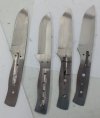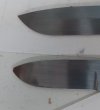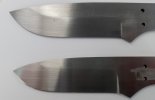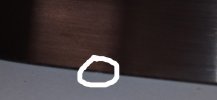- Joined
- Oct 10, 2018
- Messages
- 463
I know, it's been talked about, it's opening up a can of worms, but I'm talking about it anyway 
So I've got these blades made of 8670, hardened to 61.5 RC by JT.
I kind of want them to be a general purpose hunting/woods blade, but I'm not sure this is realistic based on my testing.
A zero edge with a 25 dps micro-bevel fails quickly when I stab the tip about 1/8" into wood. It just bends away and eventually snaps (my methodology is that the blade should be be stabbed as far in as the weight of the blade allows, hammering it into the wood is a guaranteed failure and therefore a waste).
Next I ground back to about .010, and applied the same angle micro-bevel. That does better, but the tip now breaks off in hardwood without bending (not softer wood, but that isn't to say that the soft wood hadn't already stressed it before I moved onto the oak).
Now, this is a really hard use/abuse of a knife, but I am going for something that my customer can trust in the woods not to fail. But the question is, what can the expectation really be? Prying with the tip of the knife is just asking for trouble, but what is realistic for me to shoot for in terms of having sharp geometry but being able to take some abuse from those who may not know how to properly use a knife. Obviously, if I made the knife totally indestructible it wouldn't cut very well, but where is the line?
So I've got these blades made of 8670, hardened to 61.5 RC by JT.
I kind of want them to be a general purpose hunting/woods blade, but I'm not sure this is realistic based on my testing.
A zero edge with a 25 dps micro-bevel fails quickly when I stab the tip about 1/8" into wood. It just bends away and eventually snaps (my methodology is that the blade should be be stabbed as far in as the weight of the blade allows, hammering it into the wood is a guaranteed failure and therefore a waste).
Next I ground back to about .010, and applied the same angle micro-bevel. That does better, but the tip now breaks off in hardwood without bending (not softer wood, but that isn't to say that the soft wood hadn't already stressed it before I moved onto the oak).
Now, this is a really hard use/abuse of a knife, but I am going for something that my customer can trust in the woods not to fail. But the question is, what can the expectation really be? Prying with the tip of the knife is just asking for trouble, but what is realistic for me to shoot for in terms of having sharp geometry but being able to take some abuse from those who may not know how to properly use a knife. Obviously, if I made the knife totally indestructible it wouldn't cut very well, but where is the line?





